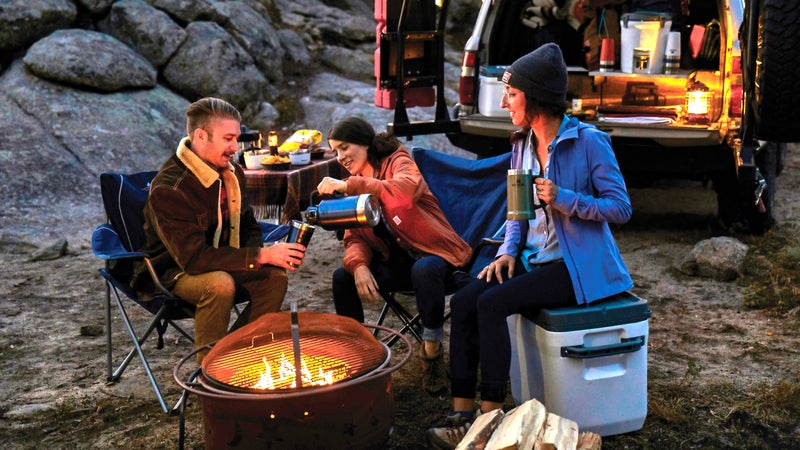There’s the one about the trucker who set his bottle down by his cab, and in a moment of distraction drove his 80,000-pound 18-wheel rig over it. It was scratched, but his coffee was still hot. Other tales include bottles that have survived 1,600-foot tumbles down mine shafts, drops out of B-29 bombers during World War II, and a gas-main explosion that reduced a Maryland hotel to cinders. And many others. When you’ve been making resilient products as long as Stanley has, the stories about how rugged your wares are pile up quickly.
It’s hard to imagine going on a hike, camping trip, or morning commute without your beloved sturdy insulated water bottle and mug. But that’s the world in which William Stanley Jr., a physicist and engineer, was living in 1913 when he created the world’s first all-steel vacuum-insulated bottle. Insulated bottles of that era were popular but fragile, as they used thin-walled glass vacuum insulation. They often shattered when dropped, and were expensive to replace.
Aladdin, once a combined brand with , has since separated but remains under the PMI umbrella.
Stanley was more than up for the challenge. Over the course of his career, he obtained more than 100 patents. He was instrumental in bringing alternating current to the United States and helped create the world’s first practical transformer, among other things. Figuring out how to create vacuum insulation between two pieces of steel took quite a bit of tinkering but the result was immediate: it literally changed the way we enjoy our favorite beverages. You no longer had to worry about breaking your thermos or bottle—and we’ve been cramming them in our packs, accidentally dropping them down mountains, and tossing them in our truck beds and backseats ever since.
Stanley marketed his invention as unbreakable and the bottles with the iconic green hammertone finish quickly became a staple of American life. are passed down from parents or grandparents, included in wedding photos, even inherited in wills. And while the toughness of the bottles hasn’t changed, how Stanley makes them has. In addition to improvements the brand has made, Stanley’s parent company PMI has been on the forefront of environmental and social responsibility for decades, including working with partner factories on everything from worker safety and water consumption to greenhouse gas emissions and solar energy usage.��But the biggest thing Stanley can do to ease the burden on the planet, says Vice President Eric Shear, is to make products that last for generations, and that people want to use.
Stanley marketed his invention as unbreakable and the bottles with the iconic green hammertone finish quickly became a staple of American life.
“We’ve done several life-cycle assessment projects,” Shear says, “and in our category, if you want to make the most sustainable, most responsible product, the most important factor is to make really, really durable stuff that lasts a very long time.” All Stanley product is backed by a lifetime warranty, but the company’s overarching goal is to make its product so durable that there’s rarely a need to take them up on that guarantee. To do that, Stanley only uses the highest-quality materials and has a quality control process that borders on obsessive. A Stanley product’s test plan can include more than 100 trials and measure everything from heat retention and leakage to corrosion and paint chips. What will happen when a bottle gets dropped into a talus field from high up on a multi-pitch climb? How will it fare when you forget it in the back of your truck bed and it rattles around for a week? Is the tea you put in your bottle still hot after sitting in your pack on an eight-hour ski tour? Those are just a sample of the questions they looked into to help develop their new Master series, which has thicker and stronger steel and better thermal performance than any other bottle on the market.
True to their founder’s spirit, Stanley’s engineers continue to tinker and experiment with new materials. When user research indicated that some customers are sensitive to the taste of metal (and said that it affects such things as the taste of their beer), and that others really like the smooth finish of their favorite ceramic mug, the company went back to the drawing board. The results, Stanley’s new , which are vacuum insulated steel with a ceramic finish, are the best of both worlds: they insulate as well as steel but without the metallic taste and odor some folks dislike.

The new Ceramivac™ products aren’t the only thing new at Stanley’s, of course. Its iconic bottles are available in an array of colors and the company now makes everything from food jars and flasks to camp cookware and coolers. Across the board, its products are more durable, stronger, and user-friendly than ever. But despite all these changes, the reason people love their Stanley products hasn’t changed a bit. They remain extremely durable and extraordinarily useful, and about as environmentally friendly as a daily use product can get. In other words, you can expect to see them everywhere from the campground to the job site for many more generations.
The Stanley brand has been part of countless adventures and even more shared memories. We have powered daily coffee breaks and just as many meals in our beloved food and beverage gear. With each passing year we continue to push ourselves to bring timeless, yet modern, solutions to today’s outdoor adventure. .��

